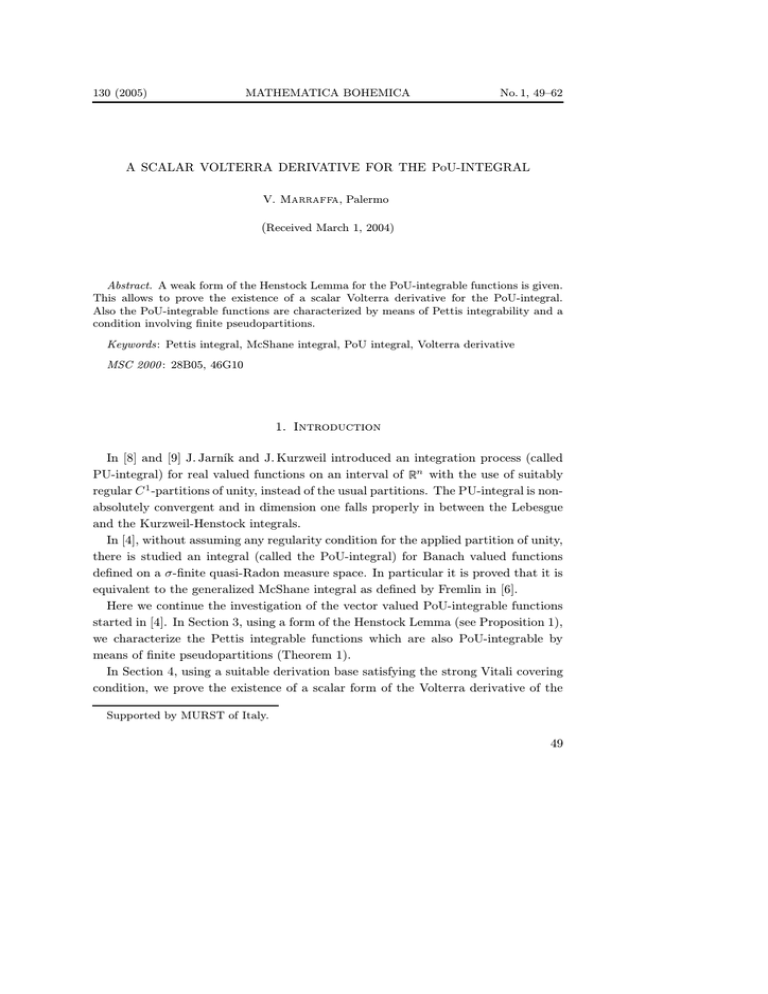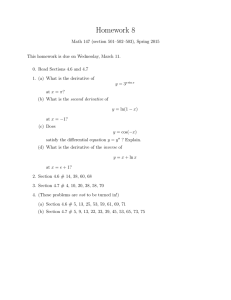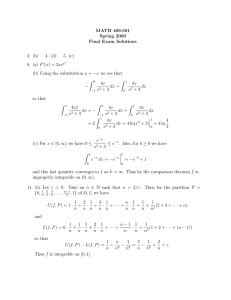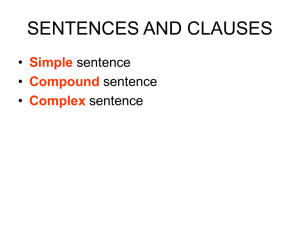A SCALAR VOLTERRA DERIVATIVE FOR THE PoU-INTEGRAL (
advertisement

130 (2005)
MATHEMATICA BOHEMICA
No. 1, 49–62
A SCALAR VOLTERRA DERIVATIVE FOR THE PoU-INTEGRAL
, Palermo
(Received March 1, 2004)
Abstract. A weak form of the Henstock Lemma for the PoU-integrable functions is given.
This allows to prove the existence of a scalar Volterra derivative for the PoU-integral.
Also the PoU-integrable functions are characterized by means of Pettis integrability and a
condition involving finite pseudopartitions.
Keywords: Pettis integral, McShane integral, PoU integral, Volterra derivative
MSC 2000 : 28B05, 46G10
1. Introduction
In [8] and [9] J. Jarník and J. Kurzweil introduced an integration process (called
PU-integral) for real valued functions on an interval of n with the use of suitably
regular C 1 -partitions of unity, instead of the usual partitions. The PU-integral is nonabsolutely convergent and in dimension one falls properly in between the Lebesgue
and the Kurzweil-Henstock integrals.
In [4], without assuming any regularity condition for the applied partition of unity,
there is studied an integral (called the PoU-integral) for Banach valued functions
defined on a σ-finite quasi-Radon measure space. In particular it is proved that it is
equivalent to the generalized McShane integral as defined by Fremlin in [6].
Here we continue the investigation of the vector valued PoU-integrable functions
started in [4]. In Section 3, using a form of the Henstock Lemma (see Proposition 1),
we characterize the Pettis integrable functions which are also PoU-integrable by
means of finite pseudopartitions (Theorem 1).
In Section 4, using a suitable derivation base satisfying the strong Vitali covering
condition, we prove the existence of a scalar form of the Volterra derivative of the
Supported by MURST of Italy.
49
PoU-integral (Theorem 2). We observe that a stronger form of Volterra derivative
for an operator associated to a PoU-integrable function cannot exist (see Remark 4).
2. Notations and definitions
Let (Ω, T , F , µ) be a non-empty σ-finite outer regular quasi-Radon measure space,
where T is the family of the open sets in Ω, and F is the family of all µ-measurable
sets. Unless specified otherwise, the terms “measure”, “measurable” and “almost
everywhere” (briefly “a.e.”) are referred to the measure µ. For a set E, we denote
by χE the characteristic function of E. A set E ⊂ Ω is called negligible if µ(E) = 0.
Given a function θ ∈ L1 (Ω, ), we set Sθ = {ω ∈ Ω : θ(ω) 6= 0}. A generalized
McShane partition (or simply an Mc-partition) (see [6] Definitions 1A) in Ω is a
countable (eventually finite) set of pairs P = {(Ei , ωi ) : i = 1, 2, . . .} where (Ei )i
is a disjointfamily ofmeasurable sets of finite measure and ωi ∈ Ω for each i =
S
1, 2 . . .. If µ Ω \ Ei = 0, we say that P is an Mc-partition of Ω. A generalized
i
pseudopartition (or simply a pseudopartition) in Ω is a countable (eventually finite)
set of pairs Q = {(θi , ωi ) : i = 1, 2, . . .} where, for each i = 1, 2, . . ., ωi ∈ Ω and
θi : Ω → are nonnegative measurable functions such that the sets Sθi are of positive
P
P
finite measure and
θi 6 1 a.e. in Ω. If
θi = 1 a.e. in Ω, we say that Q is a
i
i
pseudopartition of Ω.
Note that if P = {(Ei , ωi ) : i = 1, 2, . . .} is an Mc-partition in Ω, then P ∗ =
{(χEi , ωi ) : i = 1, 2, . . .} is a pseudopartition in Ω, called the pseudopartition induced
by P. A gauge on Ω is a function ∆ : Ω → T such that ω ∈ ∆(ω) for each ω ∈ Ω.
We say that an Mc-partition {(Ei , ωi ) : i = 1, 2, . . .} (respectively a pseudopartition
{(θi , ωi ) : i = 1, 2, . . .}) is subordinate to a gauge ∆ if Ei ⊂ ∆(ωi ) (resp. Sθi ⊂ ∆(ωi ))
for i = 1, 2, . . ..
1. If P = {(Ei , ωi ) : i = 1, 2, . . .} is an Mc-partition subordinate to a
gauge ∆, then the pseudopartition P ∗ induced by P is also subordinate to ∆.
2. It has been proved by Fremlin (see [6], Remark 1B (d)) that corresponding to each gauge ∆ there is an Mc-partition of Ω subordinate to ∆. Therefore
by Remark 1 the set of pseudopartitions subordinate to any gauge ∆ is not empty.
From now on X is a real Banach space with dual X ∗ and B(X ∗ ) is the closed unit
ball of X ∗ .
Definition 1. We recall the following definitions.
a) A function f : Ω → X is said to be Pettis integrable if x∗ f is Lebesgue integrable
on Ω for each x∗ ∈ X ∗ , and for every measurable set E ⊂ Ω there is a vector
50
R
R
ν(E) = E f ∈ X such that x∗ (ν(E)) = E x∗ f (ω) dµ for all x∗ ∈ X ∗ . The set
function ν : F → X is called the indefinite Pettis integral of f .
As it is known (cf. [1]) ν is a countably additive vector measure, continuous with
respect to µ (in the sense that for each ε > 0 there is η > 0 such that if µ(E) < η
then kν(E)k < ε).
b) A function f : Ω → X is said to be McShane integrable (see [6] Definitions 1A)
(briefly Mc-integrable), with McShane integral z ∈ X if for each ε > 0 there exists a
gauge ∆ : Ω → T such that
X
µ(Ei )f (ωi )
lim sup z −
<ε
n
i6n
for each Mc-partition {(Ei , ωi ) : i = 1, 2 . . .} of Ω subordinate to ∆.
R
If f is an Mc-integrable function on Ω we set z = (Mc) Ω f .
Definition 2 (see [4] Definition 2). A function f : Ω → X is said to be PoUintegrable with PoU-integral z ∈ X if for each ε > 0 there exists a gauge ∆ : Ω → T
such that
Z
X
lim sup z −
θi f (ωi )
<ε
n
i6n
Ω
for each pseudopartition {(θi , ωi ) : i = 1, 2, . . .} of Ω subordinate to ∆.
R
If f is a PoU-integrable function on Ω we set z = (PoU) Ω f .
3. It has been proved that the family of Mc-integrable functions coincides with the family of PoU-integrable ones (see [4] Corollary 1).
3. PoU-integral
The following proposition is a form of the Henstock Lemma for PoU-integrable
functions.
Proposition 1. Let f : Ω → X be a PoU-integrable function. Then for each
ε > 0 there exists a gauge ∆ : Ω → T such that
X
Z
Z
n
<ε
f
(ω
)
θ
−
(PoU)
θ
f
i
i
i
i=1
Ω
Ω
for each finite pseudopartition {(θi , ωi ) : i = 1, . . . , n} in Ω subordinate to ∆.
51
.
By [4] Corollary 2 for each measurable, nonnegative real valued bounded
R
function θ, also the function θf is PoU-integrable and Ω θf is well defined. Fix ε > 0
and find a gauge ∆1 : Ω → T such that
Z
Z
X
ε
<
(1)
lim sup f
−
θ
(PoU)
f
(ω
)
i
i
4
n
Ω
Ω
i6n
for each pseudopartition {(θi , ωi ) : i = 1, 2, . . .} of Ω subordinate to ∆. By Remark 3
the function f is Mc-integrable, thus according to [6] Lemma 2B we can find a gauge
∆2 such that
Z
X
ε
(2)
f (ωi )µ(Ei )
(Mc) f −
< 4
E
i6n
whenever {(Ei , ωi ) : i = 1, . . . , n} is a finite Mc-partition in Ω subordinate to ∆2
n
S
and
Ei = E. Set ∆(ω) = ∆1 (ω) ∩ ∆2 (ω). Let {(θi , ωi ) : i = 1, . . . , p} be a
i=1
finite pseudopartition in Ω subordinate to ∆. If S =
p
S
Sθi then
i=1
S1 = S θ 1 , S2 = S θ 2 \ S 1 , . . . , S p = S θ p \
p
P
assume that 1 −
θi > 0. Define
p−1
S
p
P
θi 6 χS . Set
i=1
Si . Without loss of generality, we can
i=1
i=1
θp+i =
1−
p
X
j=i
θ j χSi .
Let Q = {(θ1 , ω1 ), . . . , (θp , ωp ), (θp+1 , ω1 ), . . . , (θ2p , ωp )}. Then Q is a finite pseudopartition subordinate to ∆, indeed for i = 1, . . . , p
Sθp+i = Si ⊂ ∆(ωi ).
Moreover
2p
X
(3)
θi = χ S .
i=1
As S is a measurable subset of Ω, according to [6] Theorem 1N, for each partition
{(Fj , uj ) : j = 1, 2, . . .} of Ω \ S subordinate to ∆, we have
(4)
Z
lim sup (Mc)
m
52
f−
Ω\S
X
j6m
ε
µ(Fj )f (uj )
< 4.
Now let {(Fj , uj ) : j = 1, 2, . . .} be a fixed partition satisfying (4). For j = 1, 2, . . .,
set θ2p+j = χFj and ω2p+j = uj , then R = {(θi , ωi ) : i = 1, 2, . . .} is a pseudopartition
of Ω subordinate to ∆, therefore
Z
Z
X
ε
(5)
lim sup f
−
(PoU)
θ
f
(ω
)
i < .
i
4
n
Ω
Ω
i6n
Let x∗ ∈ B(X ∗ ). For n > 2p, by (3), we get
X
Z
Z
p ∗
x f (ωi )
θi − (PoU) f θi (6) Ω
i=1
Ω
X
Z
Z
Z
Z
2p
X
p ∗
x f (ωi ) θi − (PoU) f θi +
6 x∗ f (ωi ) θi − (PoU) f θi
+
i=1
n
X
Ω
x∗ f (ωi )
i=2p+1
Z
Ω
θi −
Ω
Z
Ω\S
Ω
i=p+1
Ω
∗ x f
X
X
Z
Z
Z
Z
n
2p ∗
∗
x f (ωi ) θi −
x f (ωi ) θi − (PoU) f θi + +
Ω
Ω
i=p+1
Ω
i=2p+1
2p
Z
Z
Z
Z
2p
n
X
X
X ∗
θi +
x∗ f (ωi ) θi −
x f (ωi ) θi − x∗ f
= Ω
i=1
Ω
i=1
Ω
i=2p+1
Ω\S
x f ∗
Ω\S
x f ∗
2p
X
Z
Z
Z
n
X ∗
µ(Fi )f (ωi ) − (Mc)
x f (ωi ) θi − (PoU) f θi + x∗
+
Ω
i=p+1
Ω
X
Z
Z
Z
n ∗
x∗ f −
θi −
x f (ωi )
6 Ω
i=1
S
n
Z
X
+
µ(F
)f
(ω
)
−
(Mc)
i
i
i=2p+1
i=2p+1
Si
Ω\S
X
Z
Z
2p ∗
x∗ f + x f (ωi ) θi − (PoU) f θi Ω\S
Ω
Ω
i=p+1
n
Z
Z ∗ X
f = x
f (ωi ) θi − (PoU) f Ω\S
Ω
i=1
Ω
X
X
Z
Z
Z
2p ∗
n
+
x f (ωi )
µ(F
)f
(ω
)
−
(Mc)
θi − (PoU) f θi + i
i
i=p+1
f Ω
i=2p+1
f
.
Ω\S
Now, evaluating the three terms separately, if n is sufficiently large, by (5), we have
n
Z
Z X
Z
Z ∗ X
n
ε
(7)
f (ωi )
θi − (PoU) f 6 f (ωi )
θi − (PoU) f x
< 4
i=1
Ω
Ω
i=1
Ω
Ω
and by (4)
(8)
X
Z
n
µ(F
)f
(ω
)
−
(Mc)
i
i
i=2p+1
ε
f
< 4.
Ω\S
53
By [4] Lemma 1 we obtain
2p
Z
X ∗
(9) x f (ωi )
i=p+1
θi − (PoU)
Si
Z
Ω
f θi X
X
Z
Z
2p
2p
(x∗ f (ωi ) − x∗ f ) dµ + 6 0
i=p+1
Li
i=p+1
L00
i
(x∗ f (ωi ) − x∗ f ) dµ,
where L0i , i = p + 1, . . . , 2p, are pairwise disjoint measurable sets with L0i ⊂ {t ∈
Si : x∗ f (t) − x∗ f (ωi ) > 0}, L00i , i = p + 1, . . . , 2p, are pairwise disjoint measurable
2p
2p
S
S
sets with L00i ⊂ {t ∈ Si : x∗ f (t) − x∗ f (ωi ) < 0}, and
Si =
(L0i ∪ L00i ). Since
i=p+1
i=p+1
{(L0i , ωi ) : i = p + 1, . . . 2p} and {(L00i , ωi ) : i = p + 1, . . . 2p} are two finite partitions
in Ω subordinate to ∆, from (2) we get
X
X
Z
Z
2p
2p
∗
∗
(10) (x f (ωi ) − x f ) dµ + 0
i=p+1
Li
i=p+1
X
Z
2p
= i=p+1
<
L0i
(x f (ωi ) − x f ) dµ
00
∗
∗
Li
X
Z
2p
∗
0 ∗
x f dµ − |Li |x f (ωi ) + i=p+1
∗
x f dµ −
L00
i
ε ε
ε
+ = .
4 4
2
|L00i |x∗ f (ωi )
By (6), (7), (8), (9) and (10) we get
p
Z
Z
X ∗
θi − (PoU) f θi < ε.
x f (ωi )
Ω
i=1
Ω
Since this is true for each x∗ ∈ B(X ∗ ) we get
X
Z
Z
p
6 ε,
f
(ω
)
θ
−
(PoU)
f
θ
i
i
i
i=1
Ω
Ω
and the assertion follows.
Proposition 2. Let f : Ω → X be a PoU-integrable function. Then for each
ε > 0 there exists a gauge ∆ : Ω → T such that
sup
Z
Z
n X
∗
x f (ωi )
θi − (PoU) θi f < ε
x∗ ∈B(X ∗ ) i=1
Ω
Ω
for each finite pseudopartition {(θi , ωi ) : i = 1, . . . , n} in Ω subordinate to ∆.
54
.
The result follows from Proposition 1 and by the standard argument
of splitting the sum of real numbers into the sum of nonnegative and negative parts
to obtain the absolute value inside the summation sign (see for instance [3] Proposition 1).
Lemma 1. Let f : Ω → X be a Pettis integrable function and let θi , i = 1, 2, . . .
P
be nonnegative functions in L1 (Ω, ) such that
θi = 1 a.e. in Ω. Then for each
i
ε > 0, there exists a natural number M such that for each n > M ,
.
Z
∞
X
Ω i=n+1
θi f < ε.
According to the σ-finiteness of µ, Ω =
S
Ωj , where Ωj are disjoint
j
measurable sets of finite measure. Since f is Pettis integrable, ν is a strongly additive
measure on F . Then (see [2] Corollary 12, p. 105) the set of variations {|x∗ ν| : x∗ ∈
B(X ∗ )} is uniformly strongly additive. So there exists a natural number K such
that
[
Z
∞
ε
(11)
|x∗ ν|
Ωk =
∞
Ω |x∗ f | dµ < 5
k
k=K+1
k=K+1
for all x∗ ∈ B(X ∗ ). Moreover, for each i = 1, 2, . . ., θi is a nonnegative real valued
essentially bounded function, so by [5] Theorem 1.1.2, θi f is Pettis integrable. Set
n
∞
n
∞
P
P
P
P
fn =
θi f . Since
θi = 1 a.e., lim fn (ω) = lim
θi f (ω) =
θi f (ω) = f (ω)
i=1
a.e. in Ω.
If T =
n
i=1
K
S
n i=1
i=1
Ωk , then T is a set of finite measure. According to the continuity of ν
k=1
with respect to µ over the set T , there exists η > 0 such that if F ⊂ T , F ∈ F , and
µ(F ) < η, then
(12)
kν(F )k 6
ε
.
5
Set now Tm = {ω ∈ T : kfp (ω) − f (ω)k 6 51 ε(1 + µ(T ))−1 for all p > m}. Then
S
µ(T \ m Tm ) = 0, and there exists a natural number M such that µ∗ (TM ) > µ(T )−η.
Let C ∈ F be such that TM ⊆ C ⊆ T and µ(C) = µ∗ (TM ). For all n > M we have
Z
Z
Z
Z
fn f−
fn = f−
(13)
C
TM
C
6
Z
TM
kf − fn k 6
TM
ε
ε
µ∗ (TM ) < .
5(1 + µ(T ))
5
55
Moreover for all x∗ ∈ X ∗ and for all n ∈ , |x∗ (fn )| 6 |x∗ (f )|, so if F is any
measurable subset of T with µ(F ) < η, by (12) we deduce
Z
Z
Z
2ε
∗
(14)
fn 6 sup
|x fn | 6 sup
|x∗ f | 6 ,
5
∗
∗
∗
∗
x ∈B(X ) F
x ∈B(X ) F
F
for each n ∈ . Let n > M ; since µ(T \ C) < η, by (11), (12), (13) and (14) we infer
Z
Z
Z
Z
Z
fn 6 f−
fn + f−
(15)
f
Ω
Ω
C
C
T \C
Z
Z
X
∞
θ
+
f
+
i f
n
∞
Ωk
T \C
n+1
k=K+1
6
Thus
R
Ω
fn converges to
R
Ω
ε ε 2ε
+ +
+ sup
5 5
5
x∗ ∈B(X ∗ )
Ω
Ω
∞
X
|x∗ f | dµ < ε.
Ωk
k=K+1
Ω i=n+1
for all n > M , by (15) we deduce that
and the assertion follows.
∞
f strongly. Since
Z
Z Z
fn −
f
=
(16)
Z
Z
∞
X
Ω i=n+1
θi f ,
θi f < ε,
The following characterization of the PoU-integral involving only finite pseudopartitions holds.
Theorem 1. Let f : Ω → X. The function f is PoU-integrable if and only if f
is Pettis integrable and for each ε > 0 there exists a gauge ∆ : Ω → T such that
for each finite pseudopartition Q = {(θi , ωi ) : i = 1, . . . , p} in Ω subordinate to ∆,
p
R
P
satisfying the inequality k Ω (1 −
θi )f k < ε, we have
i=1
X
Z
Z f (ωi )
θi −
f
< ε.
i6p
.
Ω
Ω
Assume first that f is PoU-integrable, then it is Pettis integrable. Let
ε > 0 be fixed. By the previous lemma, if θi , i = 1, 2, . . . are nonnegative functions
56
in L1 (Ω, ) such that
that for each n > M ,
∞
P
θi = 1 a.e. in Ω, then there exists a natural number M such
i=1
Z
(17)
∞
X
ε
θi f < 2.
Ω i=n+1
Moreover by Proposition 1 there is a gauge ∆ : Ω → T such that
X
Z
Z
n
ε
f (ωi )
(18)
θi − (PoU) θi f < 2
Ω
Ω
i=1
for each finite pseudopartition {(θi , ωi ) : i = 1, . . . , n} in Ω subordinate to ∆. Let
now Q = {(θi , ωi ) : i = 1, . . . , p} be a finite pseudopartition in Ω subordinate to ∆
p
R
P
θi )f k < 2ε . Then, by (17) and (18), it follows that
and such that k Ω (1 −
i=1
X
Z
Z
Z X
Z
p
p
θi − (PoU) θi f f (ωi )
f 6 θi −
f (ωi )
i=1
Ω
Ω
Ω
i=1
Ω
Z p
X
ε ε
+
θ
1
−
+ = ε.
i f <
2 2
Ω
i=1
Conversely, let f be a Pettis integrable function and let ε > 0 be fixed. By hypothesis
there is ∆ such that
X
Z Z
p
f
θ
−
f
(ω
)
i
i
< ε,
i=1
Ω
Ω
for each finite pseudopartition Q = {(θi , ωi ) : i = 1, . . . , p} of Ω subordinate to
R p
P
θi f < ε. Let R = {(ϑi , ωi ) : i = 1, 2, . . .} be a
∆ and satisfying Ω 1 −
i=1
pseudopartition of Ω subordinate to ∆. By Lemma 1 there is a natural number M
such that for each n > M ,
Z
∞
X
(19)
ϑi f < ε.
Ω i=n+1
Now for each n > M , R0 = {(ϑi , ωi ) : i = 1, . . . , n} is a finite pseudopartition
subordinate to ∆ and satisfying (19). Therefore
n
Z
Z X
f (ωi )
ϑi −
f
< ε.
i=1
Ω
Ω
Since n is large enough it follows that the function f is PoU-integrable.
57
4. Scalar Volterra derivative for the PoU-integral
In this section we will define a scalar form of the Volterra derivative for the PoUintegral of Banach valued functions f .
We recall that a derivation base on Ω (see for example [13], Chapter 8) is a
nonempty subset B of F × Ω. For a set E ⊂ Ω we write
B(E) = {(A, ω) ∈ B : A ⊂ E} and B[E] = {(A, ω) ∈ B : ω ∈ E}.
If ∆ is a gauge defined on Ω we denote by
B∆ = {(A, ω) ∈ B : A ⊂ ∆(ω)}.
We say that a base B is
• a fine base on a set E ⊂ Ω if for any ω ∈ E and for any gauge ∆ the set B∆ [{ω}]
is nonempty;
• a filtering base if for each ω ∈ Ω, the set B[{ω}] is a directed set.
It is known that the Vitali covering Theorem is an important tool for classical
derivation theorems on functions defined on subsets of n . It is perhaps worth
recalling at this point that a derivation base B with the strong Vitali property
differentiates all L1 -integrals.
Definition 3. A derivation base B satisfies the strong Vitali property if, for
every B ∗ ⊂ B, fine on a set E, and every ε > 0, there exist finitely many couples
(A1 , ω1 ), (A2 , ω2 ), . . . , (An , ωn ) in B ∗ such that the sets A1 , A2 , . . . , An are pairwise
disjoint and
n
[
µ E∇
Ai < ε,
i=1
where the symbol ∇ denotes the symmetric difference.
As usual the symbol L∞ denotes the family of all essentially bounded functions
θ : Ω → . If f is a PoU-integrable function we associate to f the operator F : L ∞ →
X, setting
(20)
F (θ) = (PoU)
Z
f θ.
Ω
Observe that since by [4] Corollary 2, essentially bounded functions are multipliers
for the PoU-integrable functions, the operator F is well defined.
In the following the symbol L will denote the family of all measurable functions
θ : Ω → such that 0 6 θ 6 1 a.e. and the set Sθ is of positive finite measure. From
58
now on we will consider the base B = {(Sθ , ω)}, where θ ∈ L . Since by Remark 2
the set of pseudopartitions subordinate to any gauge ∆ is not empty, the family B∆
is a fine base. For (Sθ1 , ω) and (Sθ2 , ω) ∈ B, define (Sθ1 , ω) (Sθ2 , ω) if there exist
two open sets Ω1 and Ω2 such that Sθ1 ⊂ Ω1 , Sθ2 ⊂ Ω2 and ω ∈ Ω2 ⊂ Ω1 . Moreover,
as the family of gauges on Ω is directed downward (see [6] Remark 1D), the base B
is filtering if we consider the induced order.
In [11], considering functions of bounded variation, a type of Volterra derivative
of the integral of a scalar valued L1 -integrable function f is defined, and it is proved
that it coincides with the function f .
We recall that a functional J : L∞ → is Volterra B-differentiable at ω ∈ Ω (see
[11]) if there is a real number α such that
J(θ)
=α
lim R
Ωθ
where the limit is taken in the directed set B[{ω}].
We extend the definition of scalar derivative of a function F given by Pettis in
[10] to the scalar Volterra derivative of an operator J : L∞ → X.
Definition 4. We say that a function g : Ω → X is a scalar Volterra B-derivative
of the operator J : L∞ → X, if for each x∗ ∈ X ∗ , the real valued functional x∗ J is
Volterra B-differentiable at almost all ω ∈ Ω and
J(θ) (21)
lim x∗ R
= x∗ g(ω)
θ
Ω
where the limit is taken in the directed set B[{ω}].
Theorem 2. Let f : Ω → X be a PoU-integrable function and let F be the
associated operator defined in (20). Assume that the derivation base B satisfies the
strong Vitali property. Then the function f is a scalar Volterra B-derivative of F .
.
Fix x∗ ∈ X ∗ and let Nx∗ be the set of all ω ∈ Ω for which (21) fails.
Given ω ∈ Nx∗ there is η(ω) > 0 such that for each gauge ∆ we can find a function
R
θ ∈ L subordinate to ∆, with Ω θ < 1/η(ω) for which
Z
Z
Z
∗
x f (ω)
> η(ω)
θ
−
(PoU)
f
θ
θ.
Ω
Ω
Ω
Fix an integer n > 1 and set Nn = {ω ∈ Nx∗ : η(ω) > 1/n}. If ε > 0, according to
Proposition 2 we find ∆1 so that
Z
Z
∞ X
∗
ε
(22)
sup
θi − (PoU) θi f <
x f (ωi )
∗
∗
2n
x ∈B(X ) i=1
Ω
Ω
59
for each pseudopartition {(θi , ωi ) : i = 1, 2, . . .} in Ω subordinate to ∆1 . Let S be
the family of all functions θ ∈ L such that Sθ ⊂ ∆(ω) for a ω ∈ Nn and for some
gauge ∆, with ∆(ω) ⊂ ∆1 (ω) and
Z
Z
Z
∗
1
x f (ω)
>
θ
−
(PoU)
f
θ
θ.
n
Ω
Ω
Ω
Then the family S ∗ = {(Sθ , ωθ )} is a fine base of Nn . Indeed for any ω ∈ Nn and
for any gauge ∆ with ∆(ωθ ) ⊂ ∆1 (ωθ ), the set S∆∗ [{ω}] is not empty. Moreover
R
we may assume that Ω θ > 21 µ(Sθ ). Since the strong Vitali property holds, there
are couples (S1 , ω1 ), (S2 , ω2 ), . . . ∈ S ∗ such that S1 , S2 , . . . are pairwise disjoint and
∞
S
µ Nn ∇
Si = 0. If θi = θSi and ωi = ωSi , then Q = {(θ1 , ω1 ), (θ2 , ω2 ), . . .} is a
i=1
pseudopartition in Ω subordinate to ∆1 . For each p, by (22), we get
p
X
µ(Si ) 6 2
i=1
p Z
X
i=1
Ω
Z
p Z
X
∗
< ε.
x
θ
f
θ
f
(ω
)
−
(PoU)
θi 6 2n
i
i
i
i=1
Ω
Ω
By the arbitrariness of ε, it follows that µ(Nn ) = 0 and as Nx∗ =
∞
S
Nn we see that
n=1
µ(Nx∗ ) = 0, and the assertion follows.
4. In the previous theorem we prove that a scalar derivative of the
operator F defined in (20) exists, that is for each x∗ ∈ X ∗ and for all ω ∈
/ N x∗ ,
where Nx∗ is a negligible set,
F (θ) = x∗ f (ω).
lim x∗ R
θ
Ω
If the previous equality holds for all ω ∈ N , where the negligible set N is independent
of x∗ , we say that the function f (ω) is the weak Volterra B-derivative of F . Observe
that the condition concerning the existence of a scalar derivative of the operator F
cannot be improved to the existence of the weak derivative as the following example
shows.
"!$#%
For each i ∈ . Let {xij } be the unit vector base in `2 arranged in a double sequence.
, define fi : [0, 1] → `2 by
(
2i xij if t ∈ [j − 1/2i , j − 1/2i + 1/4i ], j = 1, 2, . . . 2i ,
fi (t) =
ϕ
otherwise,
where ϕ denotes the null vector in `2 . Let f (t) =
∞
P
fi (t), then f : [0, 1] → `2
i=1
is Pettis integrable (see [12] Example 10.9). Since f is measurable, it is McShane
60
integrable (see [7] Theorem 17) and also PoU-integrable (see [4] Theorem 1). Let
F (θ) = (PoU)
Z
1
fθ
0
be the operator associated to f .
We recall that a function h : [0, 1] → X is the weak derivative of an operator H
defined on the family of all subintervals of [0, 1] to X, if for each x∗ ∈ X ∗ , and for
all ω outside a negligible set N ,
lim x∗
|I|→0
H(I) |I|
= x∗ h(ω)
where I is an arbitrary interval containing ω.
As showed in [12], the weak derivative of the Pettis primitive F of the function
f does not exist. Now we observe that, when θ = χ[a,b] with 0 6 a < b 6 1, in the
subnet {[a, b], ω} where ω ∈ [a, b], the scalar B-Volterra derivative of the operator
F coincides with the scalar derivative, with respect to the Lebesgue measure, of the
indefinite Pettis integral of the function f . Therefore the weak B-Volterra derivative
of F cannot exist.
&(' )$+*,#%+-.")/
. The author thanks Professor L. Di Piazza for helpful dis-
cussions and comments.
References
[1] J. Diestel, J. J. Uhl Jr.: Vector Measures. Mathematical Surveys, N.15, Amer. Math.
Soc., 1977.
[2] N. Dinculeanu: Vector Integration and Stochastic Integration in Banach Space. John
Wiley & Sons, 1999.
[3] L. Di Piazza, V. Marraffa: The McShane, PU and Henstock integrals of Banach valued
functions. Czechoslovak Math. J. 52 (2002), 609–633.
[4] L. Di Piazza, V. Marraffa: An equivalent definition of the vector-valued McShane integral by means of partitions of the unity. Studia Math. 151 (2002), 175–185.
[5] N. Dunford, B. J. Pettis: Linear operations on summable functions. Trans. Amer. Math.
Soc. 47 (1940), 323–392.
[6] D. Fremlin: The generalized McShane integral. Illinois J. Math. 39 (1995), 39–67.
[7] R. A. Gordon: The McShane integral of Banach-valued functions. Illinois J. Math. 34
(1990), 557–567.
[8] J. Jarník, J. Kurzweil: A non absolutely convergent integral which admits transformation and can be used for integration on manifolds. Czechoslovak Math. J. 35 (1985),
116–139.
[9] J. Jarník, J. Kurzweil: A new and more powerful concept of the PU-integral. Czechoslovak Math. J. 38 (1988), 8–48.
[10] B. J. Pettis: Differentiation in Banach space. Duke Math. J. 5 (1939), 254–269.
61
[11] W. F. Pfeffer: A Volterra type derivative of the Lebesgue integral. Proc. Amer. Math.
Soc. 117 (1993), 411–416.
[12] R. S. Phillips: Integration in a convex linear topological space. Trans. Amer. Math. Soc.
47 (1940), 114–145.
[13] B. S. Thomson: Differentiation. Handbook of Measure Theory, vol. I (E. Pap, ed.). Elsevier, North-Holland, 2002.
Author’s address: V. Marraffa, Department of Mathematics, University of Palermo, Via
Archirafi, 34, 90123 Palermo, Italy, e-mail: marraffa@math.unipa.it.
62






